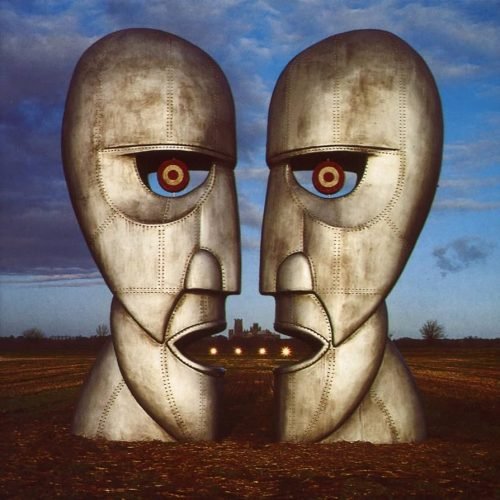Released on March 28, 1994, “The Division Bell” stands as a poignant testament to Pink Floyd’s enduring ability to evolve and resonate with listeners, even decades into their career. This fourteenth studio album marked a significant point in the band’s discography, both reflecting on past legacies and pushing into new sonic territories.
Contextualizing the Album
In the broader context of Pink Floyd’s oeuvre, “The Division Bell” emerges as a nuanced blend of continuity and change. The album followed a seven-year hiatus after their 1987 release, “A Momentary Lapse of Reason,” and was the second album without founding member Roger Waters. This period saw the band members, particularly David Gilmour and Richard Wright, reclaiming creative control, leading to a work that, while deeply rooted in Pink Floyd’s characteristic soundscapes, also ventured into more introspective and serene territory.
While the band’s earlier work, especially seminal albums like “The Dark Side of the Moon” and “The Wall,” was marked by a raw, often cynical exploration of human nature and societal constructs, “The Division Bell” takes on a more contemplative tone. It delves into themes of communication and the human condition, presenting a more reflective and, at times, reconciliatory narrative. This shift can be seen as both a departure and a deepening of Pink Floyd’s existing themes, as it melds their progressive rock roots with a mature, almost philosophical inquiry into interpersonal connections.
Artistic Intentions
“The Division Bell” was conceived with a clear intention to explore and articulate the breakdown and potential redemption of communication. This theme is woven throughout the album’s lyrics and music, echoing the band’s internal dynamics and broader societal reflections. David Gilmour and Richard Wright, in particular, aimed to capture the essence of reconnection—both personally, within the band, and universally, within human relationships.
In interviews, Gilmour has emphasized that the album’s lyrical content was heavily influenced by the personal experiences of the band members, including their own struggles and resolutions. The album’s title itself, inspired by a term used in parliamentary procedure, symbolizes division and reconciliation—a fitting metaphor for the themes Pink Floyd sought to explore.
Through songs like “High Hopes” and “Keep Talking,” the band addresses the fractures and possibilities for mending in both personal and broader contexts. The artistic vision behind “The Division Bell” is thus one of introspection and resolution, aiming to evoke a sense of understanding and closure, both for the band and their audience.
Sonic Exploration

Production Quality
“The Division Bell” is a masterclass in high production values, exemplifying the meticulous craftsmanship that has come to define Pink Floyd’s sound. The album’s production is crisp and clear, a testament to the band’s dedication to achieving sonic perfection. Engineered by Andy Jackson and co-produced by David Gilmour and Bob Ezrin, the album benefits from state-of-the-art studio techniques and technologies of the early 1990s, ensuring that every note and nuance is captured with stunning clarity.
The production quality serves the album’s themes of communication and introspection remarkably well. The pristine soundscapes allow the emotional depth of the lyrics and the subtlety of the instrumental arrangements to shine through. The decision to maintain a polished, high-fidelity sound contrasts with the lo-fi, gritty aesthetics that were gaining popularity in other genres at the time, reinforcing Pink Floyd’s commitment to creating a timeless, immersive listening experience.
Musical Arrangements
The musical arrangements on “The Division Bell” are nothing short of exquisite. The album is rich with lush layers of instrumentation, creating a sound that is both expansive and intimate. Gilmour’s signature guitar work is front and center, with soaring solos and intricate riffs that convey a range of emotions, from melancholy to hope. Richard Wright’s keyboards provide a dreamy, atmospheric backdrop, adding depth and texture to the songs.
One particularly innovative arrangement is found in the track “Keep Talking,” which features a blend of spoken word and music. The song includes a sample of Stephen Hawking’s synthesized voice, seamlessly integrated into the arrangement, emphasizing the album’s theme of communication. This interplay between human and machine voices adds a unique, futuristic dimension to the track.
The use of backing vocals and harmonies throughout the album is also noteworthy. On songs like “High Hopes” and “Poles Apart,” the layered vocals create a haunting, almost ethereal quality, enhancing the introspective and contemplative mood of the album. The careful balance between instrumental and vocal elements ensures that each track feels cohesive and emotionally resonant.
Genre Elements
“The Division Bell” primarily sits within the progressive rock genre, but it also incorporates elements of ambient, psychedelic rock, and art rock. This blend of genres is characteristic of Pink Floyd’s sound, yet on this album, it feels particularly refined and cohesive.
The ambient influences are especially evident in tracks like “Cluster One” and “Marooned,” which feature extended instrumental passages that evoke a sense of space and tranquility. These pieces highlight the band’s ability to create immersive soundscapes that transport the listener to other realms.
While “The Division Bell” remains true to Pink Floyd’s progressive rock roots, it also ventures into new territory with its use of modern production techniques and innovative arrangements. The incorporation of ambient and psychedelic elements adds depth and diversity to the album, while the overall coherence of the sound ensures that it remains a unified and compelling work.
Lyrical Analysis

Themes and Messages
“The Division Bell” delves deeply into themes of communication, division, and reconciliation. Central to the album’s narrative is the exploration of how miscommunication and misunderstandings can fracture relationships, both personal and societal. This theme is poignantly expressed through the lyrics, which often reflect on the pain of separation and the longing for connection.
Songs like “High Hopes” encapsulate the yearning for a lost past and the hope for a better future, portraying a journey of reflection and introspection. The lyrics, “The grass was greener / The light was brighter,” evoke a nostalgic sense of what once was, contrasting with the present reality. Meanwhile, “Keep Talking” directly addresses the importance of communication, using Stephen Hawking’s voice to underscore the message: “All we need to do is make sure we keep talking.”
Recurring motifs of division and unity are woven throughout the album. In “Poles Apart,” the lyrics reflect on the estrangement and differing paths of band members, perhaps alluding to the departure of Roger Waters. The lines, “Hey you, did you ever realize what you’d become?” suggest a personal reckoning with change and distance.
Lyrical Depth
The lyrics on “The Division Bell” are a blend of straightforward narrative and abstract poetry, allowing for multiple layers of interpretation. David Gilmour and Polly Samson, who co-wrote many of the songs, crafted lyrics that are both introspective and universally relatable.
The poetic nature of the lyrics can be seen in “Marooned,” which, despite being an instrumental track, conveys a sense of isolation and introspection through its title and sonic landscape. In contrast, “A Great Day for Freedom” adopts a more narrative approach, reflecting on historical and political changes with lines like, “On the day the wall came down / They threw the locks onto the ground,” alluding to the fall of the Berlin Wall and the subsequent societal shifts.
This duality in the lyrics—combining the concrete with the abstract—invites listeners to engage deeply with the songs, finding personal meaning in the broader themes.
Emotional Impact
The emotional resonance of “The Division Bell” is profound, with the lyrics playing a crucial role in evoking a range of feelings. The introspective and often somber nature of the lyrics elicits empathy and contemplation. Tracks like “High Hopes” stir a bittersweet mix of nostalgia and hope, encouraging listeners to reflect on their own experiences of loss and aspiration.
In “Wearing the Inside Out,” Richard Wright’s vocals and the lyrics’ introspective tone capture a sense of vulnerability and introspection, heightening the emotional impact. The line, “From morning to night, I stayed out of sight,” speaks to a feeling of withdrawal and self-reflection, resonating deeply with anyone who has experienced isolation.
The album’s lyrical content also fosters a sense of reconciliation and understanding. In “Coming Back to Life,” Gilmour’s lyrics explore the awakening of emotions and the rekindling of connection, with lines like, “Where were you when I was burned and broken?” ultimately leading to a sense of healing and renewal.
Cohesion and Flow

Track Progression
“The Division Bell” excels in its seamless track progression, offering a listening experience that feels both fluid and intentional. The album opens with the instrumental track “Cluster One,” which sets a contemplative, atmospheric tone that prepares listeners for the thematic journey ahead. This introduction flows naturally into “What Do You Want from Me,” a track that introduces the album’s central themes of miscommunication and relational strife with a more urgent and dynamic sound.
As the album progresses, there is a clear narrative and emotional arc. Tracks like “Poles Apart” and “Marooned” provide moments of introspection and reflection, while “A Great Day for Freedom” and “Wearing the Inside Out” delve into personal and historical reckonings. Each song transitions smoothly into the next, maintaining a consistent emotional and sonic thread that guides the listener through the album’s explorations.
The climax of this progression can be felt in “High Hopes,” the album’s closing track, which encapsulates the themes of nostalgia, loss, and hope. The somber yet uplifting nature of this final track provides a poignant conclusion, leaving the listener with a sense of closure and introspection. The careful arrangement of tracks ensures that the album tells a cohesive story, with each song contributing to the overarching narrative.
Thematic Consistency
“The Division Bell” maintains a strong thematic consistency throughout its duration. The exploration of communication, division, and reconciliation is a thread that ties all the tracks together, creating a unified thematic landscape. Even as the album shifts between different musical styles and emotional tones, this central theme remains a constant anchor.
Musically, the album balances Pink Floyd’s signature progressive rock sound with elements of ambient and psychedelic rock, creating a cohesive sonic palette. Tracks like “Marooned” and “Cluster One” emphasize ambient soundscapes that evoke a sense of space and introspection, while songs like “Keep Talking” and “Lost for Words” incorporate more traditional rock elements, yet still align with the album’s overall mood and themes.
Despite the diversity in musical arrangements, there are no jarring shifts that disrupt the album’s flow. Instead, each track complements the next, with recurring motifs and lyrical themes reinforcing the sense of a unified work. For instance, the instrumental interludes provide breathing space and reflect the contemplative nature of the album, while the more lyrically driven songs delve deeper into the personal and philosophical questions posed by the album.
Emotionally, “The Division Bell” remains consistent in its reflective and introspective tone. Even the more upbeat or dynamic tracks, like “What Do You Want from Me,” retain a sense of underlying melancholy and contemplation, ensuring that the emotional resonance is sustained throughout the album.
Standout Tracks and Moments
Highlight Key Tracks
“High Hopes”: Arguably the most iconic track on “The Division Bell,” “High Hopes” stands out for its lyrical depth, emotive melody, and sweeping instrumentation. The song captures the essence of nostalgia and longing with lines like, “The grass was greener / The light was brighter,” which evoke a poignant sense of lost innocence and the passage of time. The track’s climactic guitar solo by David Gilmour is both technically brilliant and deeply expressive, making “High Hopes” a powerful conclusion to the album.
“Marooned”: This instrumental track showcases Pink Floyd’s mastery of creating evocative soundscapes. “Marooned” is a standout for its atmospheric guitar work and ambient textures, which convey a sense of isolation and introspection without the need for words. The interplay between Gilmour’s guitar and Richard Wright’s keyboard adds layers of emotion, making it a memorable and moving piece.
“Keep Talking”: Featuring a distinctive sample of Stephen Hawking’s synthesized voice, “Keep Talking” is notable for its innovative blending of spoken word and music. The song’s theme of communication breakdown is reinforced by Hawking’s words, “All we need to do is make sure we keep talking,” which resonates deeply in the context of the album’s exploration of human connection. The track’s dynamic arrangement and compelling message make it a key highlight.
“A Great Day for Freedom”: This track stands out for its historical and emotional resonance. Reflecting on the fall of the Berlin Wall and the subsequent societal changes, “A Great Day for Freedom” combines personal and political reflection. The song’s poignant lyrics and powerful orchestration capture a sense of hope and disillusionment, making it a thought-provoking addition to the album.
Memorable Moments
Guitar Solo in “High Hopes”: David Gilmour’s guitar solo in “High Hopes” is one of the most memorable moments on the album. Its soaring, emotive quality encapsulates the song’s themes of loss and longing, creating a powerful and lasting impact on the listener. This solo not only showcases Gilmour’s technical prowess but also his ability to convey deep emotion through his instrument.
Stephen Hawking’s Voice in “Keep Talking”: The inclusion of Stephen Hawking’s voice in “Keep Talking” is a striking and innovative moment that captures the essence of the album’s theme. The synthesized speech serves as a poignant reminder of the importance of communication, adding a unique and memorable element to the track.
Atmospheric Opening of “Cluster One”: The album opens with “Cluster One,” an instrumental track that sets a contemplative tone. The gradual build-up of ambient sounds and gentle instrumentation creates a sense of anticipation and introspection, drawing the listener into the album’s reflective mood.
Lyrical Reflection in “Poles Apart”: The lyrics of “Poles Apart” provide a deeply personal reflection on estrangement and change, potentially alluding to the band’s history with Roger Waters. Lines like, “Hey you, did you ever realize what you’d become?” highlight the song’s introspective nature and add a layer of emotional depth to the album.
Vocal Performance in “Wearing the Inside Out”: Richard Wright’s vocal performance in “Wearing the Inside Out” is a standout moment. His voice, combined with the introspective lyrics and the song’s gentle arrangement, conveys a sense of vulnerability and self-examination. This track showcases Wright’s contribution to the band’s sound and adds a unique emotional texture to the album.
Artistic Contribution and Innovation

Place in Genre/Industry
“The Division Bell” holds a significant place within the progressive rock genre and the broader music industry. Released in 1994, it came at a time when the musical landscape was dominated by grunge, alternative rock, and the burgeoning electronic scene. Despite these prevailing trends, Pink Floyd stayed true to their progressive rock roots, delivering an album that was both a continuation of their legacy and a subtle reinvention.
In the context of Pink Floyd’s discography, “The Division Bell” reaffirms their status as pioneers of progressive rock. It doesn’t radically depart from the sound that defined the band’s earlier works, but it does refine and mature that sound, integrating the wisdom and experiences gained over their decades-long career. The album’s thematic focus on communication and reconciliation offers a fresh perspective within the genre, diverging from the often dystopian and existential themes of their earlier albums like “The Wall” and “Animals.”
Within the music industry, “The Division Bell” stands out for its commitment to high production values and intricate musical arrangements at a time when many bands were embracing a rawer, more stripped-down aesthetic. This commitment to sonic excellence ensured that Pink Floyd remained relevant and influential, even as musical trends shifted around them.
Innovation
“The Division Bell” is innovative in several key areas, showcasing Pink Floyd’s ability to evolve and adapt while maintaining their artistic integrity.
Production Techniques
The album’s production is a standout feature, utilizing state-of-the-art recording technology to create a pristine and immersive sound. The use of digital recording techniques, combined with traditional analog warmth, results in a sonic clarity that enhances the album’s thematic depth. The meticulous attention to detail in the mixing and mastering processes ensures that every instrument and vocal nuance is captured, providing a rich listening experience.
Integration of Spoken Word
One of the most innovative aspects of “The Division Bell” is the use of Stephen Hawking’s synthesized voice in “Keep Talking.” This integration of spoken word and music is not only a bold artistic choice but also thematically significant, underscoring the album’s exploration of communication. The blend of Hawking’s voice with the band’s music creates a unique and memorable moment that pushes the boundaries of traditional rock music.
Instrumental Exploration
The album features several instrumental tracks, such as “Cluster One” and “Marooned,” which highlight Pink Floyd’s ability to convey emotion and narrative without lyrics. These tracks rely on ambient soundscapes and intricate guitar work to create mood and atmosphere, demonstrating the band’s innovative approach to instrumental music within the rock genre.
Thematic Cohesion
The consistent exploration of communication, division, and reconciliation throughout the album represents a cohesive thematic vision that is both innovative and deeply personal. This focus on a unifying theme across all tracks creates a sense of narrative and emotional continuity, setting “The Division Bell” apart from many other albums of its time, which often lacked such cohesive storytelling.
Musical Arrangements
The complex and layered musical arrangements on “The Division Bell” showcase Pink Floyd’s innovative approach to composition. The use of orchestral elements, subtle electronic textures, and dynamic shifts in tempo and intensity all contribute to the album’s rich and varied sound. These arrangements highlight the band’s ability to blend different musical styles and influences into a coherent and engaging whole.
Closing Thoughts

“The Division Bell” is a testament to Pink Floyd’s enduring legacy and artistic prowess. The album’s strengths lie in its impeccable production quality, intricate musical arrangements, and cohesive thematic exploration. It effectively combines the band’s classic progressive rock sound with modern production techniques, resulting in a polished and immersive listening experience.
Strengths:
- Production Quality: The album’s production is immaculate, with a clear and detailed sound that enhances the emotional depth of the music.
- Musical Arrangements: The intricate arrangements and the use of both traditional and innovative instrumentation create a rich, textured sonic landscape.
- Thematic Consistency: The exploration of communication and reconciliation is handled with depth and sensitivity, providing a unifying thread throughout the album.
- Standout Tracks: Songs like “High Hopes,” “Marooned,” and “Keep Talking” highlight the band’s ability to blend lyrical depth with musical innovation.
Weaknesses:
- Pacing: Some listeners might find the album’s pacing slow, particularly with the extended instrumental sections, which could feel meandering to those expecting a more dynamic progression.
- Lyrical Ambiguity: While the abstract nature of the lyrics allows for multiple interpretations, it may also leave some listeners longing for more direct and impactful storytelling.
“The Division Bell” stands as a significant and reflective entry in Pink Floyd’s discography. It captures the band’s ability to evolve and adapt while remaining true to their core sound and thematic preoccupations. The album’s introspective nature and focus on reconciliation resonate deeply, offering listeners a contemplative and emotionally rich experience.
Official Rating
We award the album with a rating of 7/10. This rating reflects the album’s artistic merit and the skill with which Pink Floyd crafted it. While it may not reach the groundbreaking heights of “The Dark Side of the Moon” or “The Wall,” it remains a powerful and poignant work that showcases the band’s maturity and continued relevance. The meticulous production, thematic depth, and standout tracks ensure that “The Division Bell” is a rewarding listen, solidifying its place as a notable chapter in Pink Floyd’s storied career.
